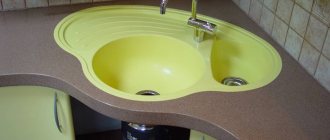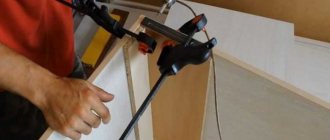The type of sink and its location largely determine the convenience of preparing dishes and the comfort of the entire kitchen. This is not only a functional item, but also part of the design of the room. Therefore, the choice of a kitchen sink must be approached with all responsibility.
We will help you decide on the optimal model and tell you where it is best to place it. We will also describe how to install a sink in the kitchen without the help of specialists. The installation technology is quite simple; the main thing is to adhere to the rules and requirements outlined in the article.
Criteria for choosing a kitchen sink
It is worth paying attention to the following characteristics of sinks:
- Functionality . Depends on the nature of the work in the kitchen. Number of bowls and wings for drying - additional compartments allow you to carry out several manipulations at the same time, which is very convenient for bulk cooking.
- Capacity . Depends on the daily number of dishes that need to be washed.
- Combination with the interior . An acrylic white sink does not always fit harmoniously into the kitchen design, so it is important to choose a model that matches the texture so as not to disrupt the integrity of the kitchen space.
Modern models can be equipped with automatic valves for adjusting the drain, as well as outlets for connecting dishwashers and washing machines.
Pay attention to the functionality of the sink. Consider whether you need the additional features that modern plumbing offers
If you install a filter block under the sink, you can pay attention to models with an additional hole for a second tap. Of course, it can also be done using a drill by drilling a through hole in the countertop.
Let's consider their types
Individual supports that are developed for mounting a bowl of a certain model. These are design works and often have an unusual configuration. Such plumbing fixtures are supplied with brackets in the form of specially shaped pins. Such fastenings are additionally treated with special compounds that carry a decorative load.
Wall-mounted sinks are fixed with cast iron and steel brackets coated with an anti-corrosion compound.
Racks are also available in various configurations (T or G), and are also made in the form of frames with a movable unit that allows you to adjust the installation. They are characterized by increased safety and stability.
The volume of the bowl affects the size of the mount. The length of the anchor is of great importance, since the depth of its insertion into the wall is at least thirty millimeters. The recommended mounting bracket size ranges from fifty to one hundred and twenty millimeters.
Where is the best place to install a sink?
Before installation, you need to consider a few simple rules that will make the operating process more ergonomic. It is customary to arrange the kitchen interior in a certain order to facilitate the work process: refrigerator, sink, dishwasher, stove and work surfaces located between them.
For convenience, the minimum distance between objects should be as follows:
- 40 cm between the stove and the refrigerator;
- 40 cm between the sink and the refrigerator/stove.
Do not install the sink near the hob. Spraying water can extinguish the flame and cause a gas leak. There must be a work area near the sink where you can cut, cut and clean food.
If you carry the same vegetables and fruits across several tables, then soon everything around will be splashed with drops of flowing water.
Choose the right place for installation. Consider the size and shape of the bowls, as well as the presence of additional drying surface
Using a sink, the kitchen can be divided into two zones, for example, for dirty work and serving.
Mounting with brackets
We remember the main rule - the strength of the surface on which the washbasin is supposed to be installed. If the surface is loose, you need to increase the drilling depth slightly, use larger-than-standard fasteners and anchors of a length appropriate for the specific case.
The process itself is not complicated:
- a line is marked at the selected height;
- the thickness of the bowl wall is measured;
- this measurement is laid down and a mark is made;
- direct fastening is carried out;
- markings are made through the recesses;
- holes are drilled, dowels are driven in;
- We install brackets;
- we bring communications;
- We carry out a final check and finally secure the washers;
- We will carefully inspect the system by opening the water and checking for leaks;
- Let's make sure the installation is secure.
Installation of mortise sinks
The most important part of this installation method is not even the cutout itself and its cut, but the quality of sealing of the joints between the sink and the countertop. Of course, the niche should be as level as possible and correspond to the size of the sink.
High-quality work will save you from hassle in the future caused by swelling of the tabletop from excess moisture.
Remember that a properly executed installation will be the key to the reliability of your kitchen. Follow these simple tips to avoid trouble in the future
There is a direct relationship between the complexity of the installation process and the size of the sink. The larger the size of the bowl, work surface and additional sections, the more difficult it is to manipulate the sink during work. But with a competent approach, using the advice of professionals, you can count on excellent results.
Installing a kitchen sink sink consists of a number of traditional steps:
Image gallery
Photo from
Stage 1: Selecting the optimal location for washing
Stage 2: Marking the hole for the kitchen sink
Stage 3: Fixing the mixer with liner
Stage 4: Attaching the sink to the hole
What you will need during the work process
Having chosen the optimal sink for your kitchen interior, you can begin installation. First you need to stock up on all the necessary tools.
During the installation process you will need:
- sealant - preferably with a feeding gun;
- electric drill;
- assembly knife, screwdriver and adjustable wrench;
- jigsaw;
- measuring tools - pencil, ruler and tape measure.
Additionally, you will need several 10-12 drills and a cardboard box.
Procedure for applying markings
So, we have a clean wooden countertop in which we need to cut a niche to fit the size of the sink. We start with markings, determining the center of the sink on the countertop. It is necessary to determine the lines of symmetry in order to position the sink symmetrically with the rest of the furniture in the kitchen.
After this, we draw the outline of the product on the tabletop itself. The contour should have a perimeter that is comparable to the widest part of the sink that is recessed under the countertop.
To create an outline, you can use a cardboard blank, which will serve as a template for applying the outline to the tabletop. This is the best option that will give high accuracy.
Use a cardboard blank to apply the most accurate outline to the base of the tabletop. Draw with a regular pencil with a highly soft lead.
The cutout should be located at least 5 cm from the front edge of the tabletop and 2.5 cm from the back. These recommended values may vary in practice, but it is best to adhere to them so that the kitchen set does not lose its integrity and strength.
This arrangement of the sink is convenient and practical, since splashes of water do not fly onto the floor, and your back does not get tired while washing dishes.
How to cut a niche?
Next, you need to drill 4 through holes using a drill that matches the size of the jigsaw blade. The holes should be close to the cut line, but not beyond the perimeter. Now, along the line strictly marked with a pencil, cut out a niche from the front side of the tabletop.
During the sawing process, you need to screw several self-tapping screws into the resulting gap from different sides as you cut. This will prevent the inside of the tabletop from falling, which could damage the finish and create long nicks.
To enter the jigsaw we use drilled holes. After complete sawing, the cut out mass will be held on by self-tapping screws. You need to remove the screws one by one, holding the slab from below. The cut must be freed from sawdust by sanding it with fine-grain sandpaper.
While the jigsaw is working, insert several screws that will prevent the cut slab from falling. Do not use the jigsaw at maximum speed, otherwise the edges of the tabletop may melt
Now you can do a test dive of the sink into the niche. Please note that the sides of the product must be fairly close to the walls of the cut. A slight play is allowed, since the sink must fit freely into the cutout.
Places that prevent complete immersion must be cut with a jigsaw. You should also think in advance about how the connection to the mixer, the siphon and the tap itself will be placed.
Step-by-step installation of plumbing
First you need to install the complete fasteners, which serve to fix the product. A layer of sealant is applied to the edges of the tabletop (on the cut side), which will protect the wooden surface from moisture penetration and prevent the wood from swelling.
To do this, you can use a rubber spatula or spread the adhesive mass with your finger. Chips on the plastic (countertop covering) around the cut are also coated.
Use caulk to coat the inside of the countertop. Please note that it can be well absorbed into the porous structure of the compressed slab
Sinks often come with a seal made of foamed polyethylene, which is glued to the back side of the sides of the sink.
If, after fixing, the seal protrudes slightly beyond the edges, then it must be carefully trimmed with the sharp end of a mounting knife. If this is not done, the protruding seal will not allow the fasteners to press the sink to the base well enough.
After this, you need to degrease the surface of the tabletop and the sealing polyethylene. We use a rag soaked in acetone or gasoline. A layer of sealant is applied to the seal in a continuous strip, but do not get too carried away with the thickness of the strip.
Plumbing manufacturers often include double-sided tape in the kit, which serves as an additional gasket between two surfaces, increasing the tightness. It is glued along the edges of the tabletop, and a layer of sealant is applied on top of it.
In practice, they often do without a seal. A sealant is used as a substitute, which fills the entire space intended for foamed polyethylene.
Next, install the sink into the countertop, pressing its edges firmly. This will allow the sealant to fill any voids, creating a tight and airtight barrier.
Using a sealant is the most practical and effective sealing method. When using it, you can easily dismantle it if necessary
But this method also has its drawbacks: high consumption of sealant (increases the time of complete drying), as well as an extremely labor-intensive dismantling process in case of unsuccessful installation or the need to replace the sink in the future.
Leveling and securing the sink
The sink is inserted into the niche and aligned with the markings. Let's take several fasteners (2-4 are enough) and at an equidistant distance from each other we begin to fasten the sink, gradually tightening the screws.
During work, we constantly monitor the position of the sink relative to the markings. You should not use a screwdriver so as not to tear off the plastic threads on the fasteners. After making sure that the sink is in the correct position, tighten the screws diagonally.
To screw in self-tapping screws, use only a screwdriver. This way you can control the degree of tightening. Using a screwdriver can miscalculate the force and damage the plastic thread
To ensure that the metal spikes of the fasteners penetrate more deeply into the surface of the tabletop, you can first sharpen them using a file, and also lightly tap them with a hammer during the final tightening of the screws. As you tighten, the sink is pressed against the countertop.
Squeezed out sealant can serve as relative evidence that the sink is pressed tightly against the base. Its excess, as well as remnants of markings, are removed with a dry cloth.
The structure should be left for a day until it dries completely and the adhesive composition crystallizes. Only then can you begin installing the mixer and connecting the sewer.
What you should pay attention to
A properly and correctly fixed bracket does not wobble or move under the influence of force. Only after making sure that it is stable and reliable, proceed to installing the sink.
Do not forget to secure it with an elastic mixture designed to seal the joints, or secure it with special clips.
Installation of a free-standing sink
The countertop sink is mainly held on the cabinet with the help of its own sides, which protrude beyond the base. These models also differ in the availability of drying space, the number of bowls, size and shape.
Choose your sink wisely. Pay attention to the shape, size and functional “buns”, such as the presence of several bowls and other bells and whistles. Based on the size of the available installation space in your kitchen
Installing this type of sink in the kitchen is much simpler compared to the previous method. The main difference is that there is no need to make a cut, which is the most time-consuming part of the process. Several installation methods are used.
Fastening with glue. The overhead sink is installed on a special cabinet, which should be smaller around the perimeter than the sink. The sides of the sink should completely overlap the ribs of the cabinet. The ends of the underframe are treated with silicone or polypropylene-based sealant.
After this, the product is placed on the stand and pressed tightly along all edges. After a few days, a completely sealed layer is created that will prevent water from leaking under the cabinet.
When the installation work is completed, you can begin connecting to the sewer system - installing a siphon.
Attachment to mounting brackets. In some cases, special fasteners are sold along with the sink. First, self-tapping screws are inserted into the inner walls of the cabinet, onto which the brackets are hung. Then the screws are screwed in ¾. After this, the sink is installed in the opening with mixing on the mounting angle.
During the maneuvering process, you need to ensure that the sink is completely pressed against the cabinet, and the self-tapping screw is fixed in the place where the corner is deepened. Then the screws are tightened until they stop.
Installation of a free-standing sink is somewhat simpler, because... implies in its design the presence of special holes and brackets for fixation
Fastening on wooden blocks. This method is used when the previous two are not suitable, for example, due to a defect in the countertop or lack of appropriate connectors on the sink. In this case, you will need 4 wooden blocks and furniture corners. Using these materials you can make an installation platform.
The height of the bars is selected so that the sink is at the same level as the rest of the kitchen furniture. The bars are cut to the size of the cabinet and fastened on the outside using furniture corners. The homemade structure is installed on the cabinet and screwed to the walls of the underframe using corners with self-tapping screws on the inside.
In the last two methods, you need to take care of tightness. To do this, apply a layer of sealant to the contact points of the cabinet/wooden platform with the sink.
Additional information on installing an overhead sink is presented in this article.
Mounting versions
One of the most common options is a wall-mounted sink. The name itself speaks about the method of fastening the structure. This type of sink is installed and attached to the wall. The location of the pipes and drain siphon assumes that communications are connected from below.
The pipes used are mainly plastic. Sinks installed against the wall are in great demand, not only due to their technical data, but also due to their reasonable price.
It is not recommended to install such products on partitions; it is fraught with the risk of falling and breaking both the object itself and the destruction of the wall.
Choose a solid base; use a solid brick or concrete wall area for this purpose. Another option is specially designed frame devices.
Construction - frame
If you find that the bathroom walls are quite weak for installing a vanity, try an interesting way to mount the sink.
A device resembling a frame and consisting of profiles attached to the floor and walls will help to cope with this complexity. It can be adjusted in height, so the sink will be located the way you want. In addition, all unsightly pipes will be hidden inside this structure.
Installing it is quite simple. The frame is positioned, secured, and the pins are screwed in at the designated level to secure the product itself. The frame is sewn up with finishing material consisting of layers of plaster and paper. Then they are lined with any decorative material of your choice.
In order to reduce noise when operating the washbasin, a rubber washer is placed on the rod located between the wall and the bowl. Then, using pins, the wall-hung sink is installed.
The installation, properly assembled, is able to withstand a fairly large load, and, as an option, it can include space with additional shelves. Beautiful, convenient, economical.











